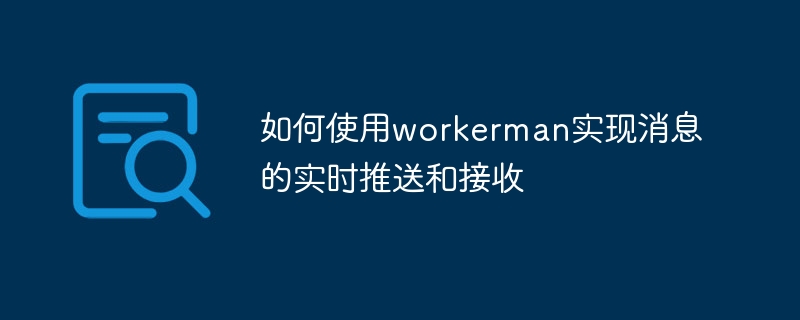How to use workererman to push and receive messages in real time

How to use workererman to implement real-time push and receive messages
With the rapid development of the Internet, real-time message push has become a requirement for many applications. In previous implementations, the server was generally polled to check whether there were new messages and then pushed. This method is not only inefficient, but also increases the burden on the server. Now, there is a more efficient way to implement it, which is to use the Workerman framework to achieve real-time push and reception of messages.
Workerman is a high-performance event-driven PHP framework designed to solve the problem that PHP cannot maintain long connections. It uses PHP's asynchronous non-blocking I/O implementation and can handle a large number of concurrent connections to achieve real-time message push and reception.
The following are the steps and code examples for using workererman to implement real-time push and receive of messages:
- Install workererman
First, you need to install it on the server worker. You can use composer to install it with the following command:
composer require workerman/workerman
- Create a message push server
Next, create a PHP file named push_server.php as a message push server.
<?php
require_once __DIR__ . '/vendor/autoload.php';
use WorkermanWorker;
$pusher = new Worker();
$pusher->count = 4;
$pusher->onWorkerStart = function ($pusher) {
$inner_ws = new Worker('websocket://127.0.0.1:8000');
$inner_ws->onConnect = function ($connection) {
echo "New client connected
";
};
$inner_ws->onMessage = function ($connection, $data) use ($pusher) {
echo "Received message: $data
";
// 接收到消息后,将消息推送给所有在线客户端
foreach ($pusher->connections as $client) {
$client->send($data);
}
};
$inner_ws->onClose = function ($connection) {
echo "Client closed
";
};
Worker::runAll();
};- Create a message receiving server
Then, create a PHP file named receive_server.php as the message receiving server.
<?php
require_once __DIR__ . '/vendor/autoload.php';
use WorkermanWorker;
$receiver = new Worker();
$receiver->count = 4;
$receiver->onWorkerStart = function ($receiver) {
$ws = new Worker('websocket://127.0.0.1:8001');
$ws->onConnect = function ($connection) {
echo "New client connected
";
};
$ws->onMessage = function ($connection, $data) {
echo "Received message: $data
";
// 处理接收到的消息
// ...
};
$ws->onClose = function ($connection) {
echo "Client closed
";
};
Worker::runAll();
};- Start the server
Finally, start the message push server and message receiving server respectively through the command line.
php push_server.php start
php receive_server.php start
At this point, the real-time push and reception of messages is completed.
In actual applications, corresponding function expansion and optimization can be carried out according to needs. For example, you can add authentication and authorization mechanisms to restrict only authenticated users to push and receive messages; you can also persist messages into a database so that offline users can receive their unread messages after they go online, etc. wait.
To summarize, by using the workerman framework, we can achieve efficient real-time message push and reception. Its asynchronous and non-blocking characteristics enable the server to handle a large number of concurrent connections, thus improving the efficiency of message transmission. I hope this article will help you understand and apply workererman to achieve real-time push and receive messages.
The above is the detailed content of How to use workererman to push and receive messages in real time. For more information, please follow other related articles on the PHP Chinese website!

Hot AI Tools

Undresser.AI Undress
AI-powered app for creating realistic nude photos

AI Clothes Remover
Online AI tool for removing clothes from photos.

Undress AI Tool
Undress images for free

Clothoff.io
AI clothes remover

Video Face Swap
Swap faces in any video effortlessly with our completely free AI face swap tool!

Hot Article

Hot Tools

Notepad++7.3.1
Easy-to-use and free code editor

SublimeText3 Chinese version
Chinese version, very easy to use

Zend Studio 13.0.1
Powerful PHP integrated development environment

Dreamweaver CS6
Visual web development tools

SublimeText3 Mac version
God-level code editing software (SublimeText3)

Hot Topics
 1386
1386
 52
52


